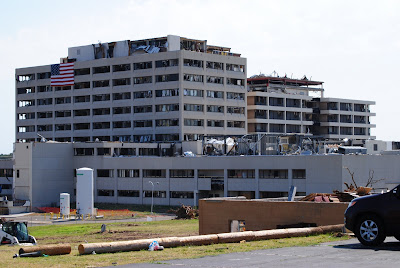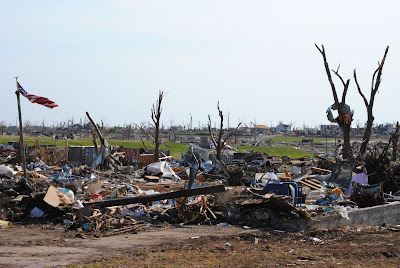Many types of jobs are necessary to get Joplin back on its feet and it will take a very long time, so there is no shortage of work that a volunteer can do. It doesn't matter what the age, language, time of stay, or physical ability of any one person may be. EVERYONE can and will make a difference.
Let me give you an idea of what it is like to spend time clearing debris from neighborhood upon neighborhood that went from their typical small town atmosphere to war-zone-like buildings reduced to piles upon piles of rubble.
In my case, I have been working with Americorps. In doing so, once registered you can decide what, when, and for how long you want to work. So most days of the past 15, I drive to MSSU (Missouri Southern State University) and sign in for the day. They give us a volunteer ID wrist band and ask us what we'd like to do. Most days I have done debris clean-up and it goes like this:
You walk from the sign-in tents over to the bus waiting to whisk you away. In the shade of a large tree (this is about the only shade I've ever stood in on debris days) tables are set up with supplies. This would include, work gloves, respirator masks, safety glasses, sunscreen, water, Gatorade ~ ~ ~ the most important items.
On the bus, an Americorps volunteer briefs you on safety considerations and rules. Drink water constantly, no less than 8 ounces an hour; wear respirators at all times so as not to breathe in dust, asbestos, fiberglass, and God-only-knows-what-else is floating around out there. They talk about keeping your eyes on everyplace you are walking as stepping on nails is the most common injury (other than the obligatory blisters). Although this is a "no-brainer" to most people, we are still reminded to stay at least 10 feet away from chainsaws in use. Continue to drink water and Gatorade.
We are then driven from the University to the Joplin High School parking lot (the school itself was totaled) where we sign in, are briefed again, and from there we are bused to the home sites. We are only allowed to clear the front and side yards of the property unless the home owners have submitted an intake form that allows us to go into the back yard and onto the foundation. The main job is to clear and sort the debris from the property by hauling it to the curb. We have to sort the materials so that it is easier on the landfills. Such piles would include construction materials, metal, vegetation (trees and branches mostly), electronics, white items ..... (don't know why they don't call them appliances), liquid contaminants, non-liquid contaminants, miscellaneous. I have to say that keeping all this separate is a challenge as there usually isn't enough curb space, but we do the best we can.
 |
| ~ This is where you ask yourself, "Where do I start?" ~ |
 |
| ~ This pile of "vegetation" was originally stacked in the backyard. We had to relocate it to the curb. It took several of us close to two hours! ~ |
 |
| ~ More 'debris engineers' arrive ~ |
Any personal items that we believe the homeowner would want to keep, we put on the foundation so they can retrieve it. Special documents such as birth certificates, photos, checks, etc., are set aside and taken to places where homeowners can also retrieve such things.
 |
| ~ I found this LarryMobile toy under a pile of twisted metal. This made me very sad because my boys loved this toy in their VeggieTales days. I hope the homeowner retrieves it. ~ |
At some point the Army Corps of Engineers will come along and load all this into trucks and haul it away to debris sites. This is where you can see the progress. Once the yards are mostly clear and the debris has been hauled away, things look relatively better. However, the remains of the homes are still there for future demolition. Most are beyond reconstruction. Most are nothing more than fireplaces or small interior rooms that many survivors took shelter in.
 |
| ~ These monsters are everywhere. There is a traffic alert in Joplin due to the amount of trips made by these and many other vehicles hauling debris. ~ |
 |
| ~ One more property ready for the next step...... demolition. ~ |
 |
| ~ Neat as a pin (after its' previous needle-in-a-haystack appearance) ~ |
 |
| ~ Not sure where the homeowners could have taken shelter here. Only a fireplace left standing after the tornado ravaged it. The other little building is on the adjacent lot. ~ |
Have I seen injuries? Yes. Usually just scratches and cuts which require immediate attention and a tetanus shot. The first day I did debris clean-up a woman walked by me and I asked her if she realized she had BLOOD all over her arm. She did not realize it and off she went to check it out and get a tetanus shot. Sometimes you don't realize you have received a cut or scratch. I looked down at my arm the other day when I was pulling boards from a heap of various debris and saw a bit of blood. I never felt it happen. This was two inches long but such a minimal surface scratch that I only cleaned it up and applied some antibiotic ointment and a large band aid.....good as new. Today I came within 6 inches of stepping on a 4 inch nail protruding from a small board that was buried under the pile of branches I was clearing. Lucky for me I constantly scan the ground and saw this just as I was about to take a step in that direction.
You know, as uncomfortable and dirty as we all get, SWEAT is a very good thing. And we do a lot of it. We are told to watch for each other and if we notice someone who no longer seems to be sweating, to alert someone as this is a sign of heat exhaustion or sun poison. One or the other, or both. Don't quote me..... all I know is it is a bad thing and to watch for it!
 |
| ~ So this is what I would look like as a surgeon ~ |
We are so fortunate to be so well taken care of. There is always someone from the Americorps team that has bottled water in hand asking if you need some. There have been times when The American Red Cross will be driving vans around with water, Gatorade, and sometimes snacks. We can takes breaks as often and for as long as we need. I can't stress how much they take care of the volunteers. The buses will come at any time we feel that we have had too much to take us back to the high school. A bus also comes to take us to the high school for lunch. They also bring lunch to the sites but that is usually for the Americorps people that work very, very, hard and are constantly on site to greet the continuous arrival of volunteers.
At the high school, other groups of volunteers are waiting for us supplying wonderful lunches. I have eaten breaded chicken, lasagna, pulled-pork wraps, BBQ beef, hotdogs, burgers, salads, yogurt, fruit, and more. The people on the food lines are adamant that we eat well. It is amazing. Luckily we work off most of this good food. I don't want to go home because I will have to make my own lunch and clean up after myself.
 |
| ~ Lunch courtesy of Relief Spark (I believe) ~ |
When we are ready, we can jump on a bus that will take us back to the University. It is not recommended to work debris clean-up all day. Keep in mind that there is no shade, it is very hard work, and the temperatures while I have been here (over two weeks) have been in the high 90s and low 100s almost everyday. I don't recall too many clouds that have given us a break from the hot, glaring sun, the heat index is often over 100 degrees. Humidity.... you betcha!!!
Each day I've cleared debris I crash for about three hours, usually not even having the energy to shower first. GROSS!!! However, I do change my clothes first before I drop.
I have to stress that all the volunteers that I have talked to feel the same way....... no matter how hard we work to clear this debris, it is worth every muscle aching minute, every drop of blood, and every ounce of sweat!!!






















